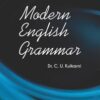Modern English Grammar
Authors:
ISBN:
₹395.00
- DESCRIPTION
- INDEX
Modern English Grammar and Usage studies the Modern ways of learning grammar and correct usages that are in practice of the native English speakers. The present work discusses the general aspects, concepts and facts related to the study of grammar. Modern English Grammar and usage are to be studied under the light of modern developments that took place in the area of language studies. Particularly it is necessary to see the efforts that were taken by modern linguists to impart a scientific dimension and apply the type of methods so as to develop a theoretical setup for the study of language. A review of these efforts is taken in the present work. Without structuralists’ view and Chomsky’s efforts one cannot go a step ahead in the direction of studies in Modern English Gr Modern English Grammar and Usage studies the Modern ways of learning grammar and correct usages that are in practice of the native English speakers. The present work discusses the general aspects, concepts and facts related to the study of grammar. Modern English Grammar and usage are to be studied under the light of modern developments that took place in the area of language studies. Particularly it is necessary to see the efforts that were taken by modern linguists to impart a scientific dimension and apply the type of methods so as to develop a theoretical setup for the study of language. A review of these efforts is taken in the present work. Without structuralists’ view and Chomsky’s efforts one cannot go a step ahead in the direction of studies in Modern English Grammar and Usage.
The present work largely strives to describe the structure of a sentence. The lessons are based on what is called as Transformational Generative Grammar.
The sources used for the present work are the material published by the then CIEFL, Hyderabad, in 1987. The material is still useful for the study of English Language, grammar and overall fields related to linguistics. ammar and Usage.
The present work largely strives to describe the structure of a sentence. The lessons are based on what is called as Transformational Generative Grammar.
The sources used for the present work are the material published by the then CIEFL, Hyderabad, in 1987. The material is still useful for the study of English Language, grammar and overall fields related to linguistics.
- The Roots of Modern English Grammar
- English Grammar at a Glance
- Introduction : 1.1 What is Grammatical?, 1.2 The Concept of Grammar – i. The Learner’s Grammar ii. The Linguist’s Grammar iii. The Teacher’s Grammar, 1.3 Why Grammar? -i. The Facts of the English Language ii. Theoretical Sophistication.
- The Need of a New Approach
- Labels Used in Grammar : 3.1 Form and Meaning, 3.2 Form and Function, 3.3 Categorical Labels – I. Open Classes (Lexical Words) i. Nouns ii. Verbs iii.Adjectives iv. Adverbs, II Closed Sets (Grammatical Words) i. Pronouns ii. Prepositions iii. Articles iv. Ordinals v. Quantifiers, vi. Demonstratives vii. Conjunctions 3.4 Functional Labels – i. Subject ii. Predicate iii. Complement iv. Object 3.5 List of Terms.
- Use of the Tree Diagrams in Gramm
- The Noun Phrase I : 5.1 What Is A Noun Phrase, 5.2 Constituents Of The NP- a. Determiners b. Ordinals, c. Quantifiers d. Adjective phrases e. Classifiers f. Pre-determiners.
- The Noun Phrase II : 6.1. Prepositional Phrases within NP’s, 6.2. Sentences Within NP’s, 6.3. More about Possessives.
- Meaning Associated with the Noun Phrase:Article Features : 7.1 Generic and Non Generic, 7.2 Specific and Non Specific, 7.3 Definite and Non Definite, 7.4 More About [+Definite]
- The Verb Group : 8.1 Preliminaries, 8.2 The Auxiliaries, 8.3 The Phrasal Verb, 8.4 Finite and Nonfinite Verb Forms
- The Meaning of Auxiliaries I : The Models : 9.1 The Present Tense Forms (Pres + Modal) – a. Will b. Shall c. Can d. May e. Must and Have to f. Ought to g. Dare and Need, 9.2 The Past Tense Forms – h. Would i. Should j. Could k. Might, 9.3 Moods, Modals and Modality
- The Meaning of Auxiliary II:The Non modal Auxiliaries : 10.1 A. The Simple Present B. The Simple Past, 10.2 A. The Present Perfect B. The Past Perfect, 10.3 The Progressive (Present and Past).
- The Predicate Phrase Patterns : 11.1 The Predicate Phrase, 11.2 Transitive and Intransitive Predicate Phrase Patterns A. Intransitive Patterns B. Transitive Patterns, 11.3 Patterns II, IV, and V in Detail, 11.4 Summary
- Interrogatives : 12.1 Preliminaries, 12.2 Yes–no interrogatives, 12.3 Usage- A. Have, Need, Dare, Used to and Ought to B. Negative Interrogatives C. Yes-No Interrogatives as Request, Exclamation and Rhetorical Question D. Disjunctives
- Wh-Interrogatives and Tags : 13.1 Wh-Interrogatives, 13.2 Tags
- The Problem of ‘Do’ : 14.1 Negation, 14.2 Emphasis, 14.3 Short response, 14.4 Conjunction reduction
- Relative Clauses : 15.1 Preliminaries, 15.2 Relativization, 15.3 Restrictive and Non Restrictive Relatives, 15.4 Other Relative Clause Types, 15.5 The Choice of the Relative Pronoun
- Complement Clauses I : 16.1 Preliminaries, 16.2 That Type, 16.3 For-T0 Type, 16.4 Poss-ing Type
- Complement Clauses II : 17.1 Interrogative Type, 17.2 Complement Clauses in Apposition, 17.3 Complement Clauses as Adjective Complements, 17.4 Raising
- Adverb : 18.1 Adverbs and Predicate Phrase, 18.2 Adverbial Clauses, 18.3 Conditional Clauses
- Coordination : 19.1 Preliminaries, 19.2 Meaning of Coordination, 19.3 Gapping, 19.4 Phrasal Coordination
- Concord : 20.1 Grammatical Concord, Notional Concord and Proximity, 20.2 With Collective Nouns, 20.3 With Coordinated Subject, 20.4 Concord of Person and the Rule of Proximity
- Bibliography








